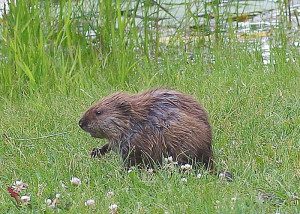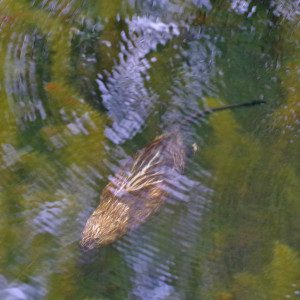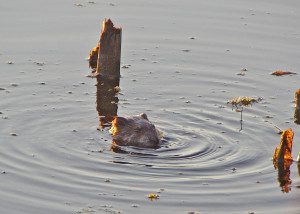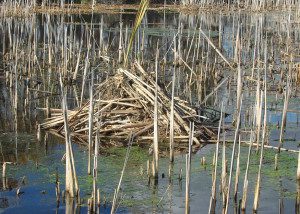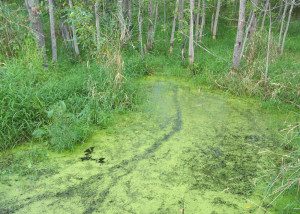Howdy, BugFans,
The BugLady wrote this article about “The Mighty Muskrat” for a recent issue of the BogHaunter, the newsletter of the Friends of the Cedarburg Bog (which you should all join). She would like to thank the mighty muskrat for its dedicated work in maintaining wetlands, the homes of an astonishing array of aquatic insects (her favorites).
Spring, 1928: “The Birch Island Fur Farms, Inc. of Saukville, announced that it would be starting a fur farm for the breeding of muskrats, beavers, raccoons, and other fur-bearing animals at Mud Lake near Saukville.” “The Crossroads,” The Saukville, Wisconsin Area, by John Boatman
Some sources say that the muskrat (Ondatra zibethicus) was so-named because it has musk glands and it looks like a large rat (it’s about the same length as a Norway rat but, at 1 ½ to 4 pounds, significantly outweighs one), but its name is probably much older. It was called “moskwas” by the Abenaki and “muscascus” (“it is red”) in one of the Algonquian languages; its genus name comes from the Huron name for muskrat. Today, it’s commonly called musquash, marsh hare, and musk beaver.
Muskrats are described as “semiaquatic rodents,” and they’re superbly adapted for life in a wetland. Their short front legs, great for digging, are too often applied to the banks of earthen dams, ponds, levees, and streams, which gets them in trouble with humans. Webbed back feet help to propel them when they swim. That scaly “rat tail,” about the same length as the body, steers them, helps move them through the water (they tuck in their front legs and move, torpedo-like, through the water), and braces them when they sit on land. An undercoat protects them from frigid water, and air that gets trapped in their fur helps them float.
It gets even better – muskrats can close off their ears and nose underwater. Like beavers, their lips are located in back of their teeth rather than in front of them, so they can hold vegetation in their mouths and even chew while swimming without flooding their throats! Like waterfowl, they practice “regional heterothermia” – that is, they can keep their feet and tail cooler than their core. Muskrats can tolerate higher concentrations of carbon dioxide than many diving mammals – handy for an animal that can spend 15 minutes under water.
Muskrats eat vegetation that they find in and around the water, snipping it off with their large incisors, but they may feed on crops in adjacent farm fields, too. They eat a variety of small animals like fish, crayfish and frogs. Muskrats don’t hibernate, and they maintain the same diet in winter. Severed cattails on the water’s surface and trails through the floating vegetation are signs of their presence.
Like other small mammals that are heavily preyed on (in the muskrat’s case by mink, foxes, coyotes, birds of prey, otters, snapping turtles, and even large pike), they breed early and often – at least twice each summer in our area and five times in the south. There are generally six to eight young per litter.
Muskrats are found throughout North America (except Florida), and south a bit into Mexico. They were introduced to Europe a century ago and are not appreciated in low-lying areas where dikes hold back the sea.
Besides excavating tunnels in stream banks, they use mud and aquatic plants to construct lodges called “push-ups” that can rise four feet above the water level and be eight or ten feet long. Lodges are built in wetlands that are at least two to four feet deep, and they provide protection from predators, a nursery, shelter in winter, and a home base for under-the-ice foraging. Muskrats also make smaller feeding platforms, and both the lodges and the feeding platforms provide mini-islands that waterfowl, turtles, and snakes can nest or loaf on.
Muskrats defend territories that they mark with “scent posts” – musk deposited on a small pile of leaves. These benign-looking animals will fight fiercely, and sometimes lethally, over potential mates. They live in family groups, from which the young are evicted if the marsh gets too crowded. A three-year-old muskrat is a very old muskrat.
Like beavers, muskrats are considered “keystone species” because of the way they shape their habitat. They live in a variety of wetland types but favor marshes because the water depth doesn’t fluctuate a lot. There, they are marsh managers.
Their populations are cyclical, with booms and busts over a six to ten year period. They love cattails and yellow water lilies, and when muskrats are abundant, their feeding on favored plants determines the vegetative composition of marsh and creates open water that is appreciated by waterfowl, wading birds, fish, frogs, and other aquatic animals. Too abundant, and they will strip a marsh of plants, turning it into a mud flat (a phenomenon called an “eat-out”) and allowing erosion. Too scarce, and the eye of the marsh grows closed again.
The fur farm was never built, but if it had been, the muskrat pelts would have been marketed as “Hudson seal” (skunk fur was sold as Alaskan or Black sable). Muskrat meat is edible, but not popularly indulged in, although Catholics in southeastern Michigan enjoyed a long-standing muskrat-dispensation from the rule that prohibited the consumption of meat on Ash Wednesday and Fridays in Lent. The Native Americans who lived around the edge of the Bog undoubtedly trapped muskrats for both food and for their warm fur.
The BugLady

